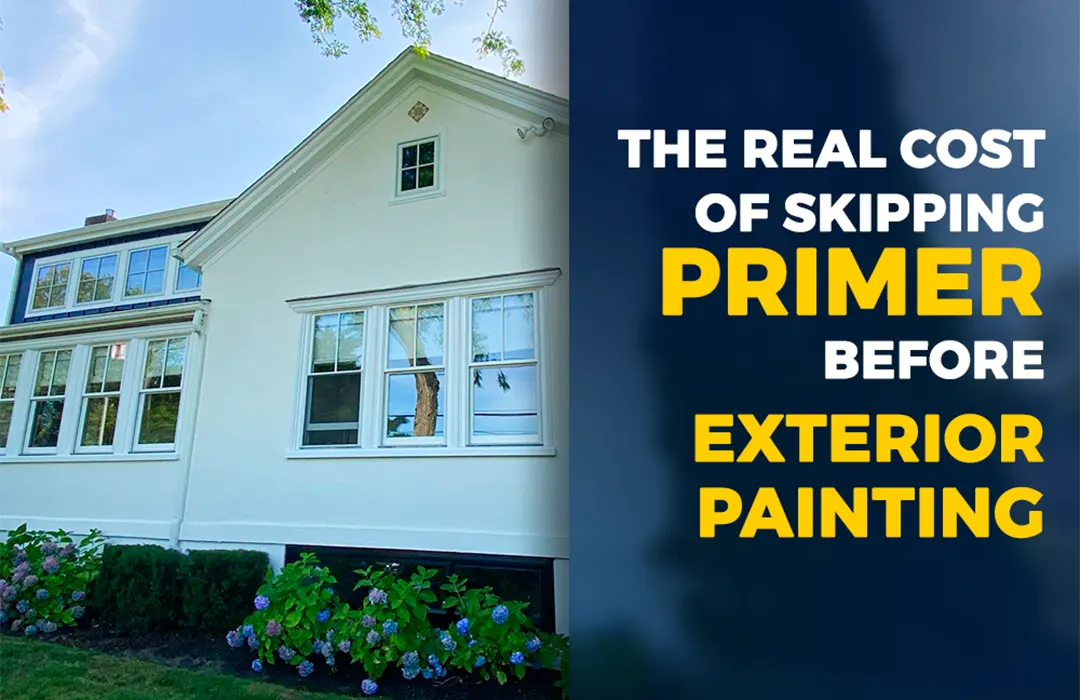When planning an exterior painting project, many homeowners focus entirely on color and finish because they’re the visible parts that boost the look. But beneath that final coat lies one of the most important steps for long-term durability: the primer.
Skipping primer might seem like a way to save time or money, but this small “shortcut” often leads to peeling paint, water damage, and costly repaints just a few years later. What looks like a quick win ends up being one of the most expensive mistakes in exterior painting.
If you live in New England, where humidity, rain, and temperature swings are constant, primer is an essential step. Let’s take a closer look at what primer actually does, what happens when you skip it, and why hiring professionals like Zuck Painting ensures your exterior painting lasts for years.
1. What primer actually does: more than a base coat
Primer is the unsung hero of every professional painting. It serves as a protective seal and bonding layer that helps paint stick properly to the surface. Whether you’re painting over bare wood, old paint, or patched areas, primer creates an even foundation that prevents problems before they start. Here’s what primer does for your home:
- Improves adhesion: Paint bonds more effectively, preventing premature peeling or flaking.
- Seals porous surfaces: Especially important for wood or masonry, which absorb moisture easily.
- Blocks stains and tannins: Stops dark spots or wood knots from bleeding through the paint.
- Enhances color accuracy: Ensures even coverage and reduces the number of coats needed.
- Protects against moisture: Acts as a barrier that prevents water from penetrating the material beneath.
Without primer, your exterior is exposed to the three biggest enemies of paint longevity: bad weather, humidity, and UV rays.
2. What really happens when you skip primer
Skipping primer is like skipping the foundation when building a house. You may not see the damage immediately, but it will show up sooner than you expect. Here’s what tends to happen:
- Peeling and flaking paint: Paint applied directly to wood or old surfaces won’t grip properly. Within a few seasons, you’ll start to see it lifting and peeling, especially after winter.
- Uneven and dull finish: Bare or patched surfaces absorb paint unevenly, resulting in inconsistent color and sheen.
- More paint needed: Because unprimed surfaces soak up paint, you’ll need extra coats to achieve proper coverage, wasting time and product.
- Water infiltration: Without the sealing layer of primer, moisture penetrates wood fibers, leading to swelling, cracking, and decay.
- Mold and mildew growth: In humid areas like Massachusetts and Rhode Island, trapped moisture quickly turns into mold, discoloring and damaging your paint.
- Shortened lifespan: A painting without primer might last 2–4 years. With proper priming, it can last 8–10 years or more.
So, what looked like a shortcut ends up forcing homeowners to repaint twice as often, doubling labor and material costs.
3. The financial reality: primer pays for itself
From a financial perspective, primer is one of the smartest investments in a painting project. It typically represents less than 10% of the total cost, yet it can double the lifespan of the paint. Let’s put that into perspective:
If an exterior painting costs $6,000 and lasts 10 years with primer, that’s $600 per year of protection. If skipping primer reduces that to 5 years, you’re effectively paying $1,200 per year for the same surface.
Additionally, skipping primer often leads to hidden repair costs, such as fixing rotted wood, sanding flaking areas, and treating mold before repainting. Over time, homeowners who skip primer can easily spend thousands more on maintenance and repairs. In short, priming before painting is a great way to save money in the long run.
4. Why professional painters never skip primer
At Zuck Painting, we know that a flawless finish starts long before the first coat of paint. Our team takes the time to clean, sand, repair, and prime every surface properly, guaranteeing a durable, high-quality result.
We use industry-leading products from Sherwin-Williams and Benjamin Moore, choosing the right primer formula for your surface type and local climate. Whether it’s wood, vinyl, or composite siding, our primers are designed to resist moisture, UV rays, and mildew.
We also understand the New England climate and tailor every exterior painting project to withstand these conditions. When you hire Zuck Painting, you’re getting:
- A fully insured team of professionals
- No subcontractors
- Fast, clean, and organized service
- A 2-year warranty for total peace of mind
This level of preparation and accountability ensures that your painting not only looks great but truly protects your home.
5. The hidden benefits of proper priming
Beyond durability and savings, priming your exterior surfaces brings other material benefits:
- Increases property value: A smoother, professional finish adds curb appeal and market value.
- Prevents long-term wood damage: Properly sealed wood resists warping and rot.
- Improves paint efficiency: Primer allows the topcoat to spread evenly, reducing overall product use.
- Keeps colors vibrant for longer: UV-resistant primers protect against fading and discoloration.
These benefits compound over time, turning a well-prepared painting into a long-term investment in your property.
6. Protect your home before it’s too late
At Zuck Painting, we make sure your home never faces those costly consequences. Our team knows exactly how to prepare and protect your exterior, from surface prep to primer selection and expert application. Don’t risk your investment with shortcuts; trust Zuck Painting to give your home the strong foundation it deserves and a finish that stands the test of time.

